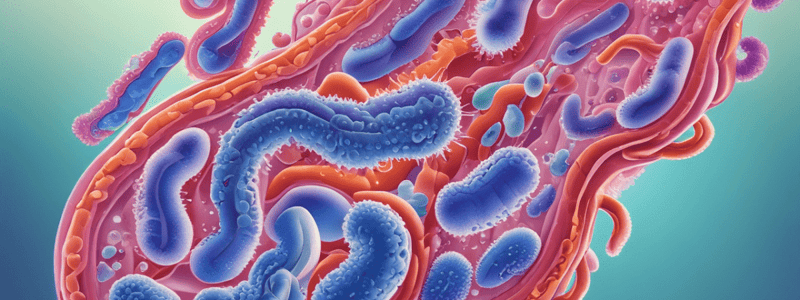Podcast
Questions and Answers
Which of the following statements about Shigella is incorrect?
Which of the following statements about Shigella is incorrect?
- It is a Gram-negative enteric bacteria that causes gastroenteritis.
- It is motile and produces hydrogen sulfide (H2S) on MacConkey agar. (correct)
- Its lipopolysaccharide (LPS) endotoxin leads to inflammation.
- It produces green colonies on Hektoen-enteric agar and is indole positive.
What is the mechanism by which Shigella causes cellular invasion?
What is the mechanism by which Shigella causes cellular invasion?
- It induces M cells in Peyer's patches to phagocytose it, then escapes the phagolysosome. (correct)
- It directly injects its toxins into host cells through a type III secretion system.
- It uses its flagella to drill through the host cell membrane.
- It secretes enzymes that digest the host cell membrane.
What is the significance of Shigella being 'acid stable'?
What is the significance of Shigella being 'acid stable'?
- It uses acid as a source of energy for its metabolism.
- It can survive in the acidic environment of the stomach. (correct)
- It produces acidic metabolites that damage host cells.
- It requires an acidic environment for optimal growth.
Which of the following is a characteristic feature of Shigella dysentery (shigelosis)?
Which of the following is a characteristic feature of Shigella dysentery (shigelosis)?
How does Shigella spread from cell to cell within the host?
How does Shigella spread from cell to cell within the host?
Which of the following complications is most commonly associated with Shigella infection in children under 10 years of age?
Which of the following complications is most commonly associated with Shigella infection in children under 10 years of age?
Which characteristic of Shigella is depicted by the 'Red Stool with flames surrounding it' in the text?
Which characteristic of Shigella is depicted by the 'Red Stool with flames surrounding it' in the text?
What does the 'Green Tutu' in the text represent about Shigella?
What does the 'Green Tutu' in the text represent about Shigella?
What does the 'Chained to the weight' in the text indicate about Shigella?
What does the 'Chained to the weight' in the text indicate about Shigella?
What is the significance of Shigella being 'acid stable' as mentioned in the text?
What is the significance of Shigella being 'acid stable' as mentioned in the text?
How does Shigella use the host cell's actin cytoskeleton as described in the text?
How does Shigella use the host cell's actin cytoskeleton as described in the text?
What is the most common complication associated with Shigella infection in children under 10 years of age?
What is the most common complication associated with Shigella infection in children under 10 years of age?
Flashcards are hidden until you start studying
Study Notes
Shigella Characteristics
- Gram-negative, enteric bacteria causing gastroenteritis
- Leads to watery diarrhea, followed by bloody diarrhea
Colony Characteristics
- Green colonies on Hektoen-enteric agar
- INDOLE POSITIVE, differentiating it from Salmonella, which grows black
Motility and Metabolism
- Immotile, non-lactose fermentation on MacConkey agar
- Non-H2S producing
Pathogenesis
- LPS (endotoxin) leads to inflammation and tissue damage
- Causes cellular membrane ruffling, leading to cell-to-cell passage
- Facultative intracellular, similar to Salmonella
Disease and Symptoms
- Causes Shigellosis, a severe form of enterocolitis
- Presents with fever, lower abdominal cramps, tenesmus, and bloody, inflammatory diarrhea
Complications
- Can lead to Hemolytic Uremic Syndrome (HUS) in children under 10 years old
Studying That Suits You
Use AI to generate personalized quizzes and flashcards to suit your learning preferences.




